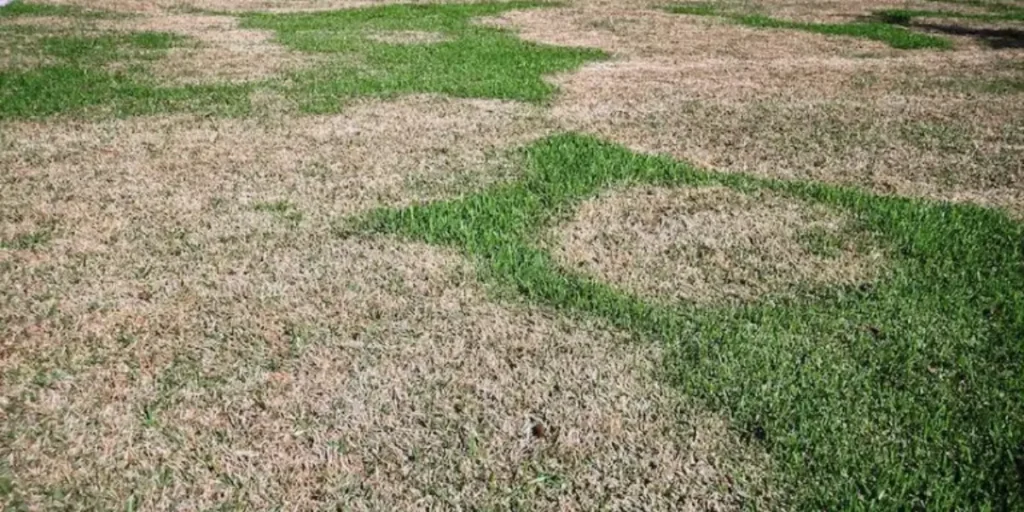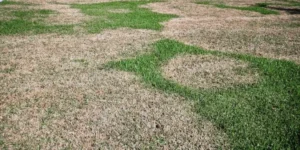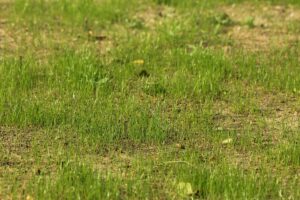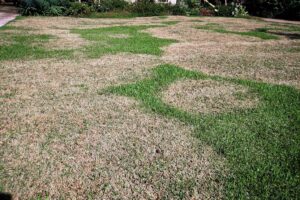Have you noticed large brown patches suddenly showing up in your lawn after all of the recent rainfall? You’re not alone. In York County and Lake Wylie, SC, this is a common issue, especially during hot, humid weeks when the weather seems perfect for grass but actually invites disease.
The culprit is a fast-spreading fungal lawn disease called brown patch, and it thrives in the exact conditions we often see in the Carolinas: soggy soil, warm nights, and lingering moisture.
Many homeowners are surprised to learn that too much water can damage their grass just as quickly as drought.
At Hippo Turf Care, we deal with brown patch outbreaks all the time, so we know how frustrating and sudden they can be. The good news? If you act early and apply the right treatment, your lawn can recover.
In this guide, we’ll show you what causes brown patch, how to identify it, and most importantly, how to control and prevent it before it takes over your yard.
What Is Brown Patch Disease?
Brown patch disease is a fungal infection caused by Rhizoctonia solani. It mainly affects cool-season grasses, including tall fescue and perennial ryegrass—two popular lawn types here in South Carolina.
It usually shows up in the summer when daytime temperatures are high and nights stay warm (above 68°F). Add in humidity and frequent rain or watering, and you’ve got the perfect environment for brown patch to thrive.
The fungus lives in the soil and becomes active when conditions are right. Once it starts, it damages the blades of grass and creates unsightly patches that spread fast if not treated.
What Causes Brown Patch to Appear?
Brown patch doesn’t just happen out of nowhere. Several common lawn care habits, and even natural weather patterns, can create the perfect conditions for it to take over.
Using too much nitrogen fertilizer in the summer can make your grass more vulnerable. Watering late in the evening or overwatering keeps your lawn wet overnight, something the fungus loves.
And after heavy rain, the soil often stays saturated for too long, especially if drainage is poor, which adds even more fuel to the fire.
Mowing your grass too short or using dull mower blades can also damage the grass, making it easier for the disease to take hold. Thick layers of thatch and poor airflow, especially in shady or compacted areas, trap moisture and heat right at the surface.
When these factors combine, especially after a rainy stretch, brown patch disease can spread fast and leave your lawn looking patchy and stressed.
How to Spot Brown Patch Disease
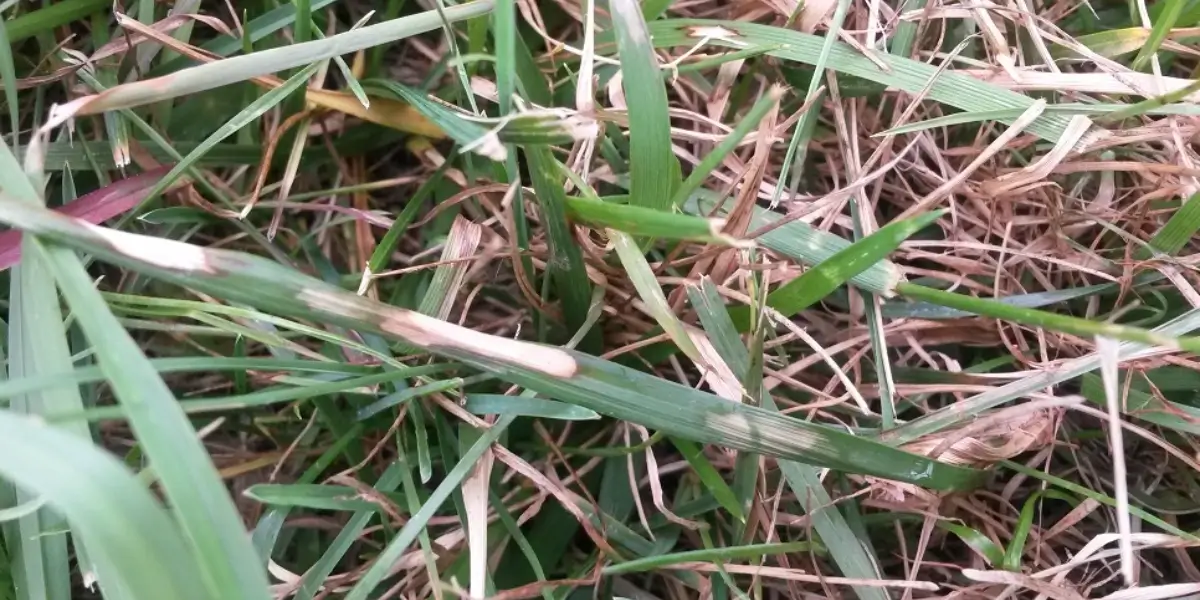
Brown patch disease often starts subtly, but it spreads fast, especially after rainfall followed by warm, humid nights. The most noticeable sign is circular, brown patches in your lawn that range from a few inches to several feet wide.
You might also see a darker “smoke ring” or outline around the patches, especially in the morning when the lawn is still damp with dew. Up close, the grass blades will have tan or light brown spots with dark edges.
The infected areas might feel slimy or look matted down, and there’s often a faint musty smell that signals fungus is at work.
If your lawn suddenly looks patchy or discolored after a stretch of wet weather, brown patch could be the reason.
Tips to Prevent Brown Patch
Preventing brown patch disease starts with how you care for your lawn day to day. The goal is to reduce excess moisture, strengthen your grass, and create conditions where the fungus can’t thrive.
Water smart. Always water early in the morning, never at night. This gives your lawn time to dry out before the sun sets. Avoid overwatering, especially if it’s already been raining.
Fertilize carefully. Don’t overload your lawn with nitrogen during the warmer months. Too much nitrogen encourages fast, soft growth that’s more vulnerable to fungus.
Mow high and sharp. Mow at the recommended height for your grass type, and always use a sharp blade. Cutting too short or tearing the grass can weaken it and increase your risk of disease.
Reduce thatch and improve airflow. Thick thatch traps moisture. Aerate your lawn annually and dethatch if needed. Also, trim surrounding plants or bushes to improve airflow and reduce humidity near the soil.
When these simple steps are part of your regular lawn routine, your grass stands a much better chance of staying healthy, even during wet, muggy weather.
Using Fungicides Effectively
Sometimes, even with great lawn care habits, brown patch still shows up, especially after stretches of rain and high humidity. When that happens, fungicides can play an important role in controlling the spread.
For home lawns, it’s best to apply a preventive fungicide when you know the weather is turning warm and wet, typically late spring into summer here in York County and Lake Wylie.
Look for products that contain active ingredients like azoxystrobin, propiconazole, or flutolanil, which are known to be effective against brown patch.
If you’re already seeing signs of infection, a curative fungicide can help stop it from getting worse. Just remember, timing is everything; fungicides work best when applied early in the disease cycle, not after the lawn is already heavily damaged.
It’s also important not to rely on chemicals alone. Without proper mowing, watering, and fertilization, the fungus can keep coming back. That’s why we always recommend combining fungicide treatments with solid lawn care practices.
Why Choose a Lawn Care Pro Like Hippo Turf Care
Brown patch can be tricky. It often resembles other problems, such as drought stress, weed invasion, or grub damage, and it spreads rapidly if misdiagnosed or left untreated. That’s where we come in.
We understand the unique challenges of maintaining a healthy lawn in the humid South Carolina climate. We know how to spot brown patch early, how to treat it properly, and, most importantly, how to keep it from coming back.
Our approach includes custom lawn evaluations, proper fertilization plans, core aeration, and targeted fungicide treatments when needed.
We also help prevent other lawn problems that can create stress and weaken your turf, like aggressive weeds competing for space and nutrients. That’s why we offer professional weed control services that work alongside disease prevention to keep your lawn strong and resilient.
Plus, we keep an eye on local weather patterns (like heavy rain or heat waves) so we can act fast when conditions start to turn against your lawn.
With the right care and expert support, your yard can stay lush and green all season long, without the brown blotches.
Request Your Lawn Assessment Today
Think your lawn might be at risk for brown patch, or already showing signs? Let’s take a look. At Hippo Turf Care, we offer professional lawn health evaluations to identify problems early and recommend the best solutions.
Whether you’re in Lake Wylie, Rock Hill, Fort Mill, or anywhere nearby, we’ve got you covered. Our experienced team is local, knowledgeable, and results-driven, with a reputation for helping lawns recover fast and stay healthy longer.
Reach out today to schedule your lawn assessment in Lawn Wylie and York County, and let us show you what your yard is capable of.
Final Thoughts
Brown patch disease is frustrating, but it’s manageable with the right approach. By mowing properly, watering wisely, improving airflow, and using fungicides when needed, you can keep your lawn green and fungus-free, even through hot, humid summers and rainy spells.
The key is early action and consistent care, and that’s where we come in. Partner with Hippo Turf Care for expert support, tailored lawn care, and a healthier lawn you can be proud of.

